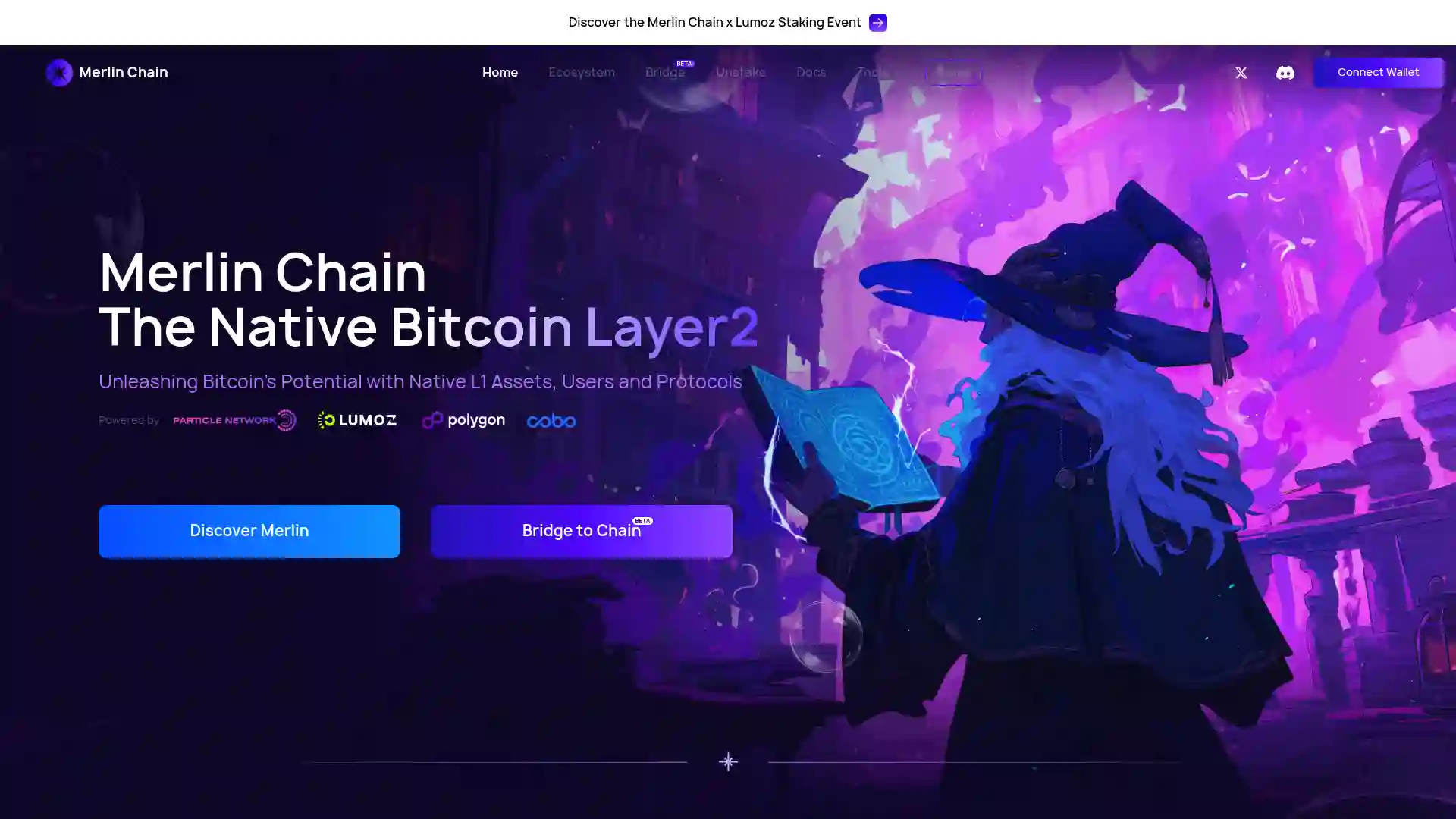Merlin Chain (MERL)
Merlin Chain, founded by Jeff Yin and launched in 2024 by Bitmap Technology, is a Bitcoin Layer 2 solution. Its purpose is to enhance Bitcoin's native assets, protocols, and applications, increasing scalability, efficiency, and functionality within the Bitcoin network. Key features include a ZK-Rollup Network, a Decentralized Oracle Network, and mechanisms for data availability and fraud detection, all leveraging Bitcoin's infrastructure. The platform supports Ethereum Virtual Machine (EVM) compatibility and integrates with Bitcoin-native wallets. It bridges Bitcoin with over 40 Ethereum chains, simplifying adoption and fostering cross-chain interactions. Its launchpad system supports asset inscription and valuation, driving innovation within the Bitcoin ecosystem.
Key modules
ZK-Rollup Network

| Ticker | MERL |
| Category | Smart Contract Platform |
| Website | https://merlinchain.io/ |
| @MerlinLayer2 | |
| Telegram | merlin_chain |
| Contract Addresses | |
|---|---|
| merlin-chain | 0x5c...78 Copied! Copied! |
| ethereum | 0x0f...6d Copied! Copied! |
The ZK-Rollup Network is crucial for scalability and security, aggregating transaction data into batches verified with zero-knowledge proofs and linked to Bitcoin's mainnet via Taproot. This system includes nodes for data processing, a zkProver using SNARK technology for transaction validation, and a database for storing Merkle Tree and transaction details. Benefits include enhanced security, EVM compatibility, cost reduction through optimized data usage, and high performance, meeting large-scale user demands.
Decentralized Oracle Network
Merlin Chain’s Decentralized Oracle Network handles data securely by using sequencer nodes, which batch transactions and generate ZK state proofs. It reduces centralization risks with fraud-proof mechanisms, multi-signature protocols, and cold storage. The network supports staking multiple assets, automates rewards through smart contracts, and offers real-time monitoring and flexible withdrawal systems.
Data availability
Merlin Chain collaborates with Celestia and Nubit to ensure transparent block data publication. This solution provides public access to network states, allowing anyone to view and store Merlin Chain’s data. Nodes verify the availability of new blocks, ensuring data completeness and consistency across the network.
Two-step ZKP submission mechanism
This mechanism, inspired by Lumoz, enables decentralized Proof of Work (PoW). Provers generate a ZKP for a sequence, calculate its hash, and submit it to a chain-level smart contract. After the T+11 block, provers can submit the complete ZKP, validating the hashes. Verified provers receive rewards based on their stake proportion, enhancing system efficiency and security.
Fraud detection
Merlin Chain uses a fraud-proof mechanism involving Provers and Verifiers. Provers pre-sign transactions and convert programs into binary circuits with NAND logic gates, organized into a Merkle Tree. Verifiers retrieve and validate the Merkle Root for authenticity. If discrepancies arise, a challenge-response process ensures data accuracy, strengthening correctness.
Merlin Phantom
Merlin Phantom is an asset exchange protocol on Merlin Chain, facilitating the exchange of Bitcoin-based assets like RUNES, BRC-20, BRC-420, and Ordinals NFTs. Developed with UniCross, it enhances liquidity and broadens BTC asset use cases.
Tokenomics
Merlin Chain Token ($MERL)
MERL has a capped supply of 2,100,000,000 tokens, released over four years starting from the Token Generation Event (TGE). As a BRC-20 token, MERL is vital for governance, security, and transaction efficiency within the Merlin Chain ecosystem.
Token utility
- Governance: MERL holders can vote on proposals, driving community-based governance.
- Staking: MERL can be staked for network security and to prevent Sybil attacks.
- Transaction fees: Used for paying transaction fees within the ecosystem.
- Delegating to consensus nodes: Holders can delegate MERL to nodes, supporting decentralization.
- Native liquidity and collateral: MERL serves as liquidity and collateral, aiding transactions and lending mechanisms.
Merlin's Seal
Merlin's Seal is a staking event where participants earn M-points and claim $MERL, with 20% of the total supply allocated as rewards. Users stake assets, converted to $BTC for daily M-point calculation, determining $MERL shares. Rewards also include liquidity provision and participation in DeFi protocols. Supported assets include BTC, BRC-20 tokens, ETH, USDT, and USDC. Staking can be done via wallets like UniSat, OKX, and Bitget, with bonus rewards for team leaders based on staked value.
M-Token
M-Token represents Layer 1 assets staked on Merlin Chain during the "Merlin's Seal" event. Users receive M-Tokens for staked assets like Bitcoin or Ethereum, with the ability to mint them without gas fees and exchange 1:1 for original assets upon unlocking. M-Tokens also facilitate NFT interactions, including metadata like Layer 1 NFT numbers and inscription IDs. Original assets can be claimed by destroying M-Tokens during the unlocking process, which began in April 2024.
